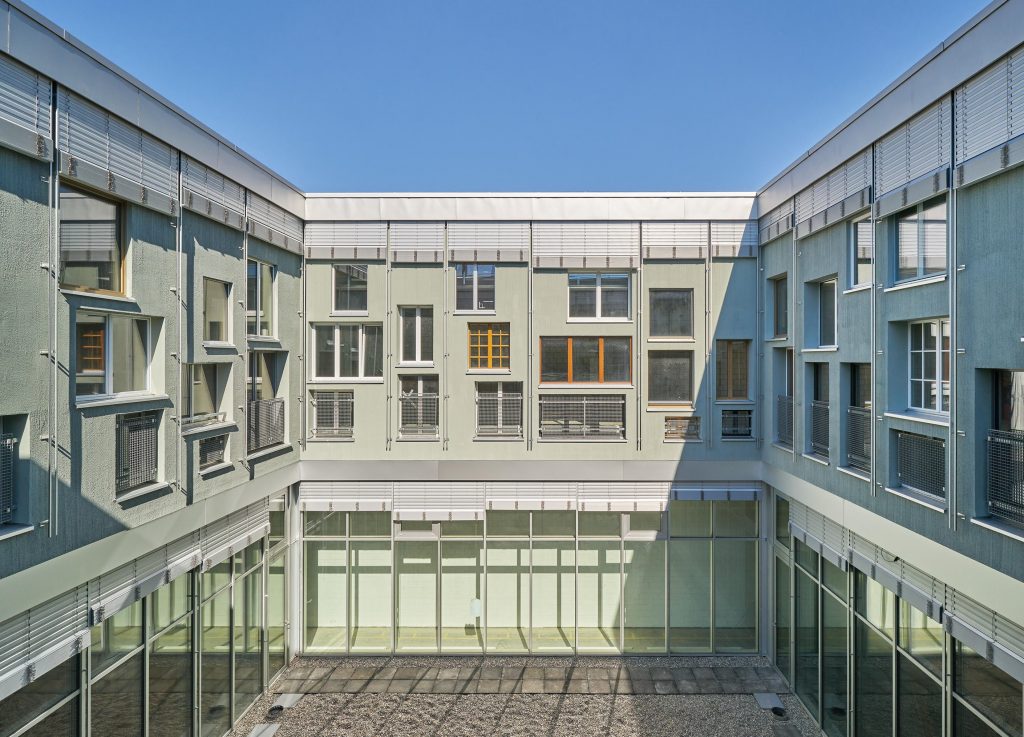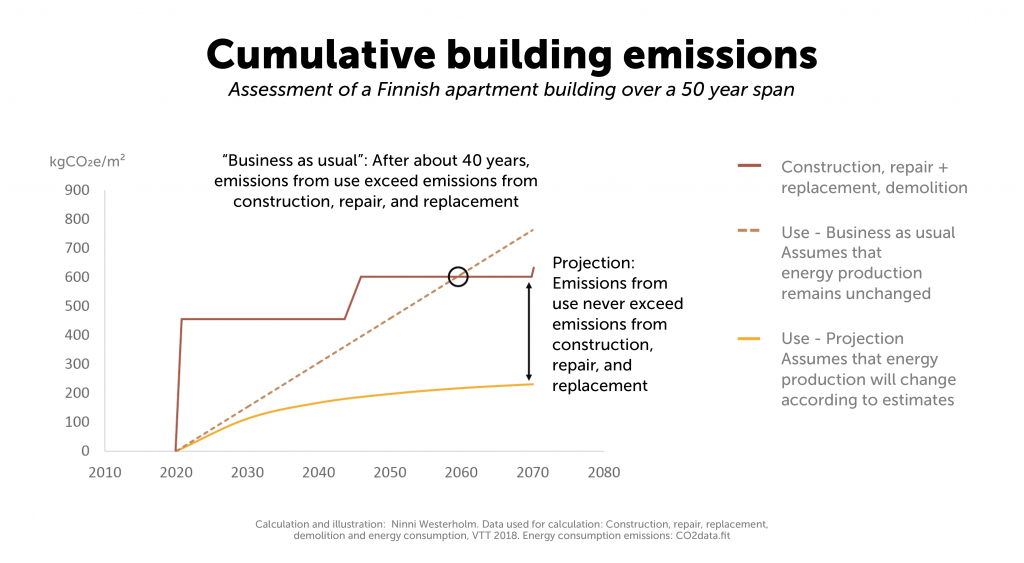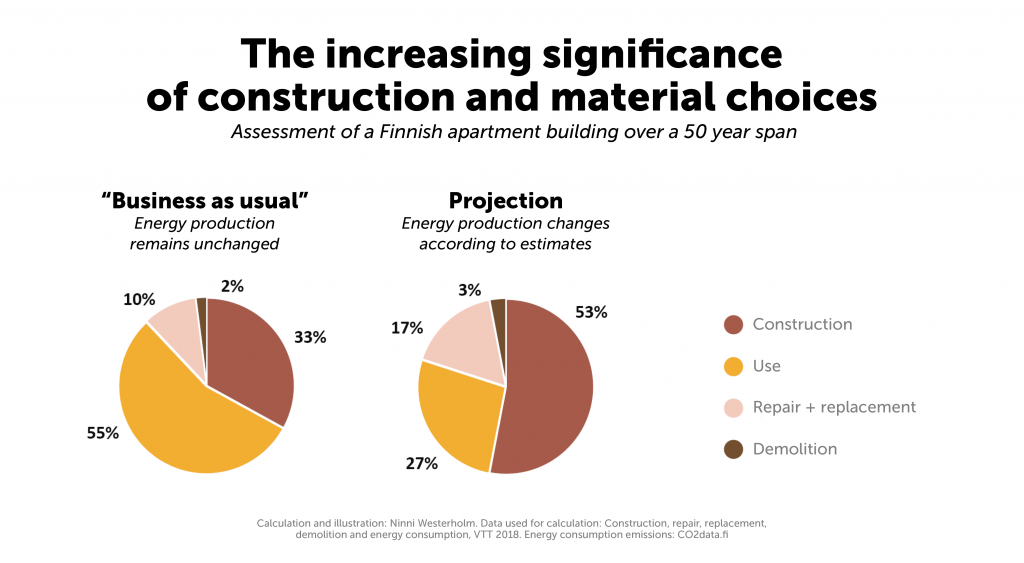
Construction’s environmental impact – wood and recycled materials help us face the future
Since construction is responsible for over a third of the world’s CO2 emissions, its carbon footprint must be reduced to prevent adverse climate effects. Switching to wood or recycled materials is an effective measure the industry can take.
Teksti: Ninni Westerholm
Read the article in Finnish: Rakentamisen ympäristövaikutukset – Puu ja kierrätysmateriaalit osana tarvittavaa murrosta

We are all becoming familiar with phenomena such as loss of biodiversity, global warming, increasingly extreme weather, and polluted environments. One way or another, they are all linked to our collective overconsumption.
The currently prevailing “take, make, and dispose” economy, also called a linear economic system, alternately assigns value to products and then takes it away again.
In contrast, a circular economy strives to operate within the limits of what our environment can handle, making it a much more environmentally friendly alternative. A circular economy relies on efficiently maintaining the value of products for as long as possible by reusing and recycling them. The goal is also to eliminate waste and emissions by thinking ahead. [1]
Circular economy approaches should also be introduced to construction – one of the industries with the greatest environmental impact. Buildings and construction account for 35% of our emissions and for 40% of energy consumption [2]. Construction also generates 33% of our waste, making it the largest waste generating sector [3]. Buildings and construction use 50% of our natural resources [4]. Extraction and processing of natural resources account for 90% of the loss of biodiversity [5].
Construction has an enormous environmental impact. This is why the entire sector is in urgent need of revolutionary changes if we want to comply with the Paris Climate Agreement and ensure a healthy future for ourselves and the environment. The Paris Climate Agreement limits emissions to a level that would increase global warming by 1.5°C. With current policies, the projected global emissions for 2030 are more than double this limit [6].
The significance of building materials
Since construction is a threat to the environment, we must relearn our approach to construction and the building materials we use. Renovating buildings is almost always a better choice for the environment than new construction. Despite the growing need to reduce emissions, there is no way new construction will end in the foreseeable future.
Advocates of sustainable construction have long emphasised how important energy efficiency is in new construction and how emissions during the building’s actual use are higher than during construction. The latter is only true, however, if energy production is assumed to remain the same during the building’s use. But this is not a likely scenario. The energy industry is becoming more and more low-carbon whereas construction emissions cannot be reduced once construction is over. Waste levels from construction and its material choices are also far higher than from building use.
The figure below illustrates when and where emissions are generated for a traditional Finnish apartment building. The red line in the figure represents emissions generated by construction, repair, replacement, and demolition. The orange dashed line shows cumulative emissions from use assuming that energy production remains unchanged. The yellow line illustrates a more likely, forecast-based estimate of emissions from use.

Calculation and illustration: Ninni Westerholm. Data used for calculation: Construction, repair, replacement, demolition and energy consumption, VTT 2018. Energy consumption emissions: CO2data.fi
The figure shows that emissions from use are never projected to exceed emissions from construction. Looking at totals over a span of 50 years, construction, repair, replacement, and demolition make up an estimated 73% of emissions, while use is only 27% (Figure 2). These numbers are nearly the polar opposite of the old assumptions.

Calculation and illustration: Ninni Westerholm. Data used for calculation: Construction, repair, replacement, demolition and energy consumption, VTT 2018. Energy consumption emissions: CO2data.fi
The intention here is not to minimise the importance of energy efficiency. Rather, this highlights the fact that we must quickly gain control over our emissions. For buildings, this means that we will be forced to reduce the carbon footprint from construction to reduce its adverse effects on the climate.
Minimising negative environmental impacts
Using wood in construction is an effective way to shrink a building’s carbon footprint. Switching a frame from concrete to wood can reduce its carbon footprint by somewhere between 34% and 84% [7]. When a builder elects to use a wood frame, energy efficiency does not need to suffer: wooden buildings can also be made energy efficient.

Wood’s carbon footprint is small compared to other common building materials, and wood also serves as carbon storage. It is a great carbon sink when used properly, as the amount of carbon emissions generated during processing is far smaller than the carbon sequestered during use. Wood is also a renewable material. Almost 110 million m3 of wood grows in Finnish forests every year [8], and its annual usage rate is currently about 60-65% [9]. As long as the wood is sourced from sustainably managed forests, there is still room for an increase of around 15-20 million m3 per year [10].
Our society very much relies on sand for construction, making it the most widely used resource after water. Sand is an essential ingredient in concrete production, but sustainably mined sand is not as common as it would need to be. Scientists say this is one of the greatest challenges to sustainable development in the 21st century. [11]
Emissions savings can be gained by using wood, but building with recycled materials enables even greater savings. In a circular economy, wood is very much used in construction. A prime example is the ELYS Commerce and Culture House in Basel, Switzerland. The old building was given a new look and new purpose, with Baubüro in situ Architects leading the design process. The existing concrete frame was left in place, but the outer shell was redone. These prefabricated exterior wall elements have a wood frame, the thermal insulation is mineral wool, and the facade is made from sheet metal – and these are all recycled materials, including the windows.
Puuinfo’s forthcoming educational material this spring will include more inspiring examples of circular economy houses and information on the environmental impacts of wood construction.
CREDITS
Ninni Westerholm
Circular Economics Researcher, Tampere University, Graduate School of Industrial Wood Construction
Architect and sustainable construction consultant, HELST Arkkitehdit Oy
Life cycle assessment toolkit developer, LASKE Oy

References
1. Ellen MacArthur Foundation (n.d.) What is circular economy. Luettavissa: https://www.ellenmacarthurfoundation.org/circular-economy/what-is-the-circular-economy
2. European Comission (2020) Construction. Luettavissa: https://ec.europa.eu/growth/sectors/construction/.
3. European Comission (n.d.) Construction and demolition waste. Luettavissa: https://ec.europa.eu/environment/topics/waste-and-recycling/construction-and-demolition-waste_en.
4. Global Alliance for Buildings and Construction [GlobalABC] (2019) 2019 Global Status Report for Buildings and Construction. Luettavissa: https://globalabc.org/sites/default/files/2020-03/GSR2019.pdf.
5. International Research Panel (2019) Global Resources Outlook 2019: Natural Resources for the Future We Want. Luettavissa: https://www.resourcepanel.org/reports/global-resources-outlook.
6. Stockholm Environment Institute [SEI], International Institute for Sustainable Development, ODI, E3G, United Nations Environment Programme [UNEP] (2021) The production gap. Luettavissa: https://productiongap.org/wp-content/uploads/2021/11/PGR2021_web_rev.pdf.
7. Skullestad, J. L., Bohne, R. A. and Lohne, J. (2016) High-rise Timber Buildings as a Climate Change Mitigation Measure – A Comparative LCA of Structural System Alternatives. Luettavissa: https://www.researchgate.net/publication/309013583_High-Rise_Timber_Buildings_as_a_Climate_Change_Mitigation_Measure_-A_Comparative_LCA_of_Structural_System_Alternatives
8. Luonnonvarakeskus [LUKE] (2017) Suomen metsävaratietoja. Luettavissa: https://www.luke.fi/wp-content/uploads/2017/06/Liite_Suomen_metsavaratietoja.pdf.
9. LUKE (2020) Hakkuukertymä ja puuston poistuma alueittain 2020. Luettavissa: https://stat.luke.fi/hakkuukertymä-ja-puuston-poistuma-alueittain-2020_fi.
10. Heino, P. (2019) Tausta-aineistoa puurakentamisen keskusteluun. Luettavissa: https://smy.fi/wp-content/uploads/2019/05/PMA46_Tausta-aineistoa-puurakentamiskeskusteluun.pdf.
11. UNEP (2019) Sand and sustainability : finding new solutions for environmental governance of global sand resources. UNEP. Luettavissa: https://unepgrid.ch/storage/app/media/documents/Sand_and_sustainability_UNEP_2019.pdf.
CO2data.fi. Rakentamisen päästötietokanta. Luettavissa: https://co2data.fi
VTT (2018) Rakennusten khk-päästöjen ohjauksen vaikutusten arviointi. Luettavissa: https://www.vttresearch.com/sites/default/files/pdf/technology/2018/T324.pdf